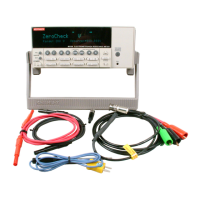IEEE-488 Reference
3-98
:AUTO <b>|ONCE
[:SENSe[1]]:VOLTage[:DC]:DIGits:AUTO <b>|ONCE Control auto resolution; Volts
[:SENSe[1]]:CURRent[:DC]:DIGits:AUTO <b>|ONCE Control auto resolution; Amps
[:SENSe[1]:RESistance:DIGits:AUTO <b>|ONCE Control auto resolution; Ohms
[:SENSe[1]]:CHARge:DIGits:AUTO <b>|ONCE Control auto resolution; Coulombs
Parameters <b> = 1 or ON Enable auto resolution
0 or OFF Disable auto resolution
ONCE Enable and then disable auto resolution
Query :AUTO? Query state of auto resolution
These commands are used to enable or disable auto resolution for the specified function. With
auto resolution selected, the instrument automatically selects the optimum resolution for the
present integration time setting (see Table 2-18).
The ONCE parameter is analogous to a momentary toggle switch. When :AUTO ONCE is sent,
auto resolution turns on momentarily and then disables. While enabled, resolution is selected
automatically. Auto resolution then disables but the selected value is retained.
The auto resolution command (:DIGits:AUTO) is coupled to the command that manually selects
resolution (:DIGits <n>). When auto resolution is enabled, the parameter value for :DIGits <n>
changes to the automatically selected resolution value. Thus, when auto resolution is disabled,
the instrument remains at the automatically selected resolution.
3.19.10 :AVERage commands
The :AVERage commands are used to configure and control the digital filter. See paragraph 2.17
for details.
:TYPE <name>
[:SENSe[1]]:VOLTage[:DC]:AVERage:TYPE <name> Select filter type; Volts
[:SENSe[1]]:CURRent[:DC]:AVERage:TYPE <name> Select filter type; Amps
[:SENSe[1]:RESistance:AVERage:TYPE <name> Select filter type; Ohms
[:SENSe[1]]:CHARge:AVERage:TYPE <name> Select filter type; Volts
Parameters <name> = NONE No digital filter selected
SCALar Select scalar filter
ADVanced Select advanced filter
Query :TYPE? Query the digital filter type
Description This command is used to select the digital filter type. The SCALar filter is a simple averaging
type filter. The ADVanced filter is similar except that it incorporates a noise "window" to allow
faster response time to large signal step changes. The :NTOLerance command is used to set the
window for the ADVanced filter.
The number of readings that are averaged by the filter is set with the :COUNt command, and the
:TCONtrol command is used to select the filter mode (moving or repeating). The [:STATe] com-
mand is used to enable or disable the filter.
Setting TYPE to NONE with MEDian:STATe set to OFF will set AVER:STATe to OFF.

